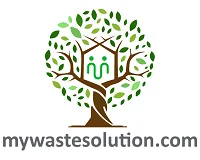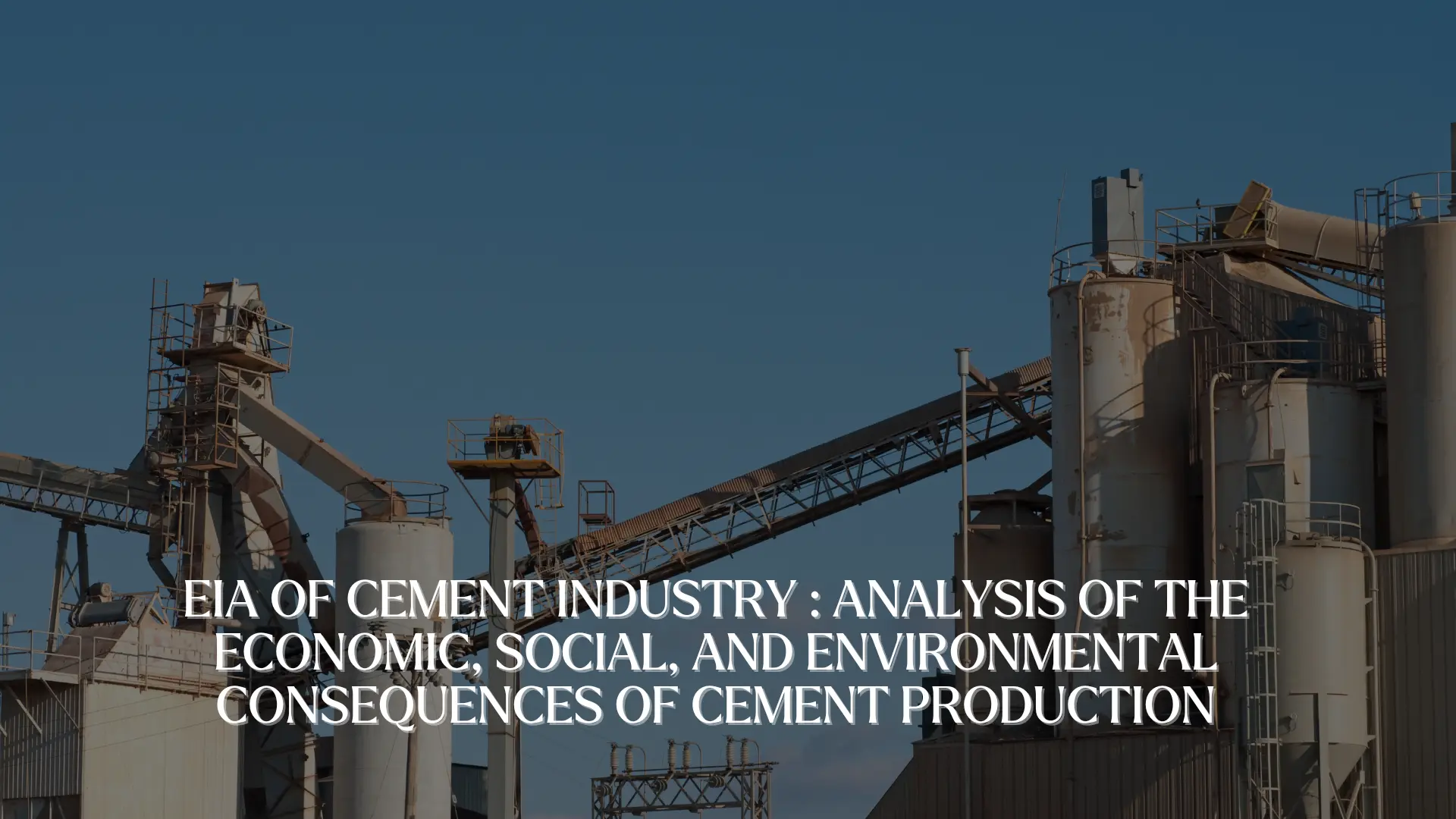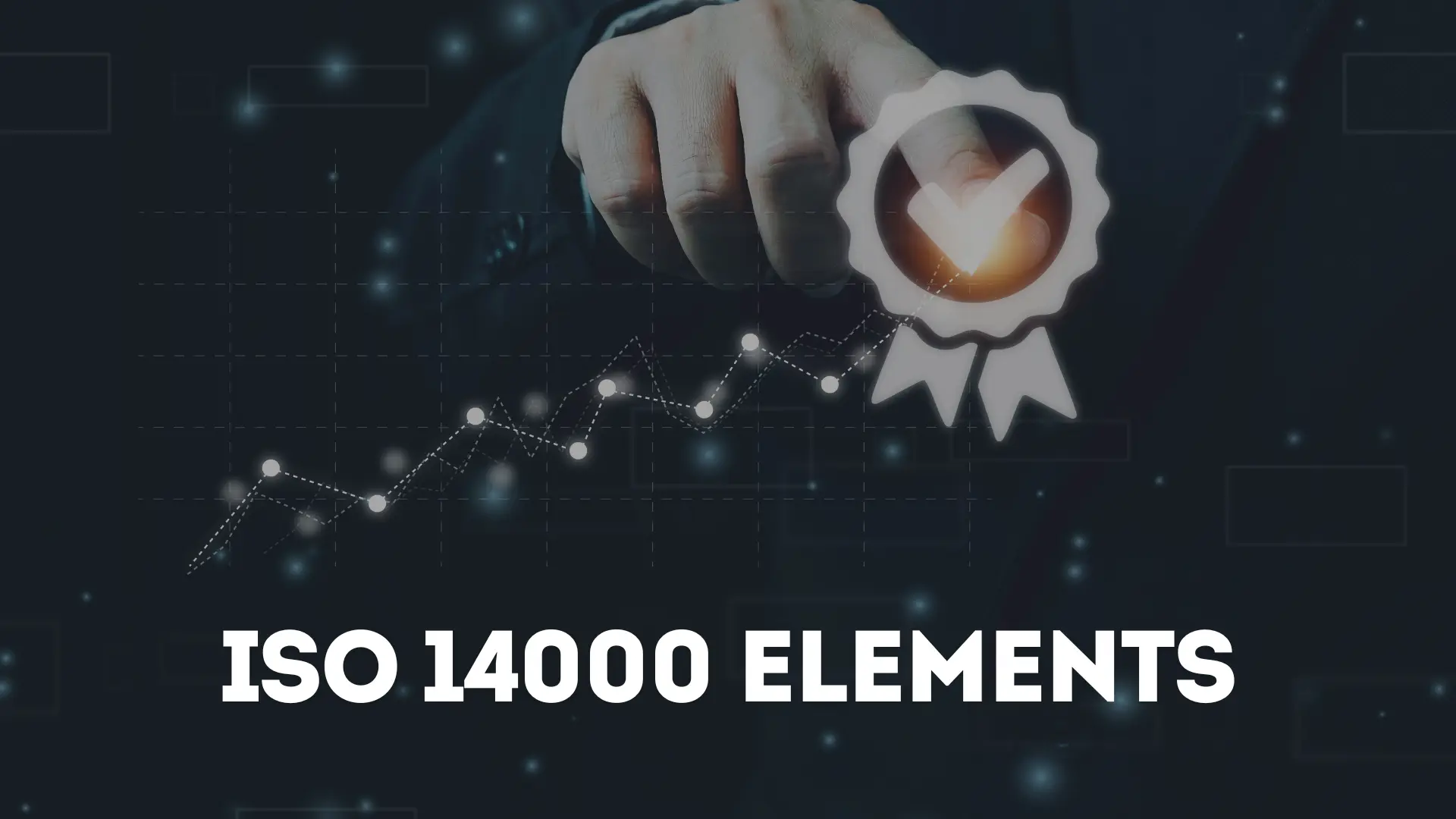EIA stands for Environmental Impact Assessment. UNEP (United Nations Environment Programme) defines Environmental Impact Assessment (EIA) as a tool used to identify the environmental, social and economic impacts of a project prior to decision-making. Today we are going to look at one of the most important processes of EIA for the cement industry.
With increase in developmental projects around the world, the need for cement has been increased. Although cement does help to construct very strong projects. But it has been observed that the cement industry shows a very negative impact on the environment. Thus EIA of the Cement industry will contribute to environmentally friendly practices. As a result of the EIA of the cement industry, it will help us to identify the environmental, social and economic impacts of a cement industry.
Cement Industry
To know about the process of EIA of the Cement industry we need to understand the significance of cement. The fundamental component of constructions in civil engineering and architecture is cement. In 1824, Portland cement, the most used type of cement for concrete building, was patented. The output of the cement industry closely mirrors the state of the economy as a whole because it is directly tied to how the construction industry is doing generally. Calcium oxide, silica, aluminium oxide, and iron oxide are the primary components of the silicates and calcium aluminates that make up cement, which is a combination of compounds. India has the second-largest cement industry in the world. The government’s liberalisation initiatives, which began with partial decontrol in 1982 and culminated in comprehensive decontrol in 1989, led to an unheard-of growth in the Indian cement sector. Thus EIA for the cement industry will help us to identify the environmental, social and economic impacts of a cement industry.
Process for EIA of Cement Industry
Let’s have a look towards the EIA Process for the cement industry. A team of consultants with competence in researching the various facets of the development site should be responsible for creating the EIA of the cement industry. The team should be led by a project manager who has the necessary amount of relevant expertise and whose primary duty it is to coordinate the contributions of various specialists and to offer an overview. To provide complete professional coverage, the EIA research could be carried out by a business or joint venture of specialists. In this article we are going to study the EIA of Cement Industry and for that we have to look at the steps first which are involved in EIA Process of cement industry.
Explore Environmental Management System Solutions
Find top machinery, plants, tools, resources, companies, and consultancy for comprehensive cement industry EIA needs.
There should be several steps in the EIA process :
- What kind of projects are they, their sizes, expected components and processes, and what phases will they be implemented in?
- Is an EIA necessary for screening?
- What must be covered in the formal EIA and to what extent? Scoping, or the identification of potential environmental impacts
- Basis: What are the current environmental circumstances?
- What kind of effects will the project have on the environment?
- Evaluation: What implications will these have on people and resources, and how severe are the consequences?
- Mitigation: Can substantial adverse effects be prevented or made tolerable? Can advantages be increased?

Struggling with EIA needs for cement industry? Connect with top consultants specializing in EIA solutions.
Connect NowEssentials of an EIA Document
The Environmental Impact Assessment (EIA) document may include an overview of the cement industry in a particular country. The current level of production in that nation, details of the environmental impact assessment of the cement industry, such as project description and need, pertinent institutional information, a description of the affected area, the process of making cement, impact prediction, impact assessment, and impact mitigation measures.
The EIA of cement industry required documents that are; non-technical executive summary, project description and need (PDN), project location proposal, and potential environmental requirements or outputs (stresses) such as land requirements, air pollution emissions, water usage and water pollutant emissions, waste generation and disposal requirements. A project’s necessity at a specific place must also be covered in the document.
Now we’re going to study for EIA of Cement Industry in India:
EIA of Cement Industry in India
Overview
The nation is currently the second-largest cement manufacturer in the world. Cement and clinker in significant quantities are now being exported from India. The first cement mill opened in Porbandar, Gujarat, in 1914, launching the country’s cement industry. Since then, the industry has grown steadily, but in the beginning, particularly in the years leading up to Independence, the growth had been extremely slow. The cement sector has lost its licence. Additionally, it has been designated a priority industry in Schedule III of the Industry Policy Statement, making it eligible for automatic clearance of foreign investment up to 51% and technical collaboration under the customary terms of royalty payments and lump-sum know-how fees.
Present status in India
We should know for the EIA of Cement Industry there are two sectors in the cement industry: one is made up of major facilities, and the other is made up of little cement plants. A large cement plant is one that has an installed capacity greater than 297000 tonnes per year (900 tonnes per day), while a tiny cement plant has a capacity up to and including that amount. 2012 (Excise). In addition to the micro and white cement plants with an estimated total annual capacity of 6 million tonnes, there were 171 big cement plants with a total installed annual capacity of 290.48 million tonnes in 2010–11. Cement Corporation of India, which has 10 plants, is the sole Central Public Sector Undertaking in the cement industry (Indian Minerals Yearbook 2011 (Part II) 2012). Several State Governments collectively own ten sizable cement plants. The breakdown of installed capacity between large and small cement plants is as follows:
Indian Cement Industry (April 2008)
| Plants | No. of Plants | Installed Capacity(In million tonnes) |
| Private Sector Plants | 100 | 102.89 |
| Cement Corporation of India | 10 | 3.85 |
| Others owned by State Government | 10 | 5.27 |
| Total | 120 | 112.01 |
| Mini Cement Plants | 300 | 9.00 |
| Grand total | 121.01 |
Note: Total and Grand Total also include a capacity of 2.41 million tonnes of closed units.
Find and connect with leading companies specialising in EIA solutions for cement industry.
Get Connected Today
Cement Production
As we are discussing about the EIA of Cement Industry in this article we should know how cement is produced. Here we are going to study cement Production and methods of cement Production.
Raw elements like limestone, chalk, shale, clay, and sand are used to make cement. The right chemical composition is achieved by mining, crushing, finely grinding, and blending these raw ingredients (US EPA, 2010).
Mining, crushing, and grinding of raw materials (primarily limestone and clay), blending of raw meal, calcining of materials in a rotary kiln, cooling of the resulting clinker, combining the clinker with gypsum, and milling, storing, and bagging of the finished cement are all steps in the cement manufacturing process. Iron, lime (calcareous), silica (siliceous), alumina (argillaceous), and silica can be considered the four main raw elements needed to produce cement (ferriferous). To make one tonne of cement, approximately 1450 kilogrammes (kg) of dry raw ingredients are needed. About 35% of the weight of the raw material is lost as carbon dioxide (CO2) and water vapour. Beginning with the disintegration of clay minerals into SiO2 and Al2O3 on the one hand, and calcium carbonate (CaCO3) at around 900 °C to release calcium oxide (CaO, lime), the basic chemistry of cement production begins. The latter method is referred to as calcination. The next step is the clinkering process, in which the calcium oxide (CaO) combines with silica, alumina, and ferrous oxide at a high temperature (usually 1450 °C) to produce calcium silicates, aluminates, and ferrites. In order to create cement, the resulting clinker is subsequently combined with gypsum and other additives.
Cement is produced using four primary process routes. The raw components are ground and dried to create raw meal, which is then transformed into a flowable powder. The pre-heater, precalciner, or, less frequently, a long dry kiln is fed with the dry raw food.
- SEMI-DRY PROCESS — Dry raw food is palletized with water and fed into a long kiln with crosses or a grate preheater before the kiln.
- SEMI-WET PROCESS: In filter presses, the slurry (see below for the wet process) is first dewatered. For the purpose of producing raw meal, the filter cake is extruded into pellets and fed either directly to a filter cake dryer or a grate pre-heater.
- WET PROCESS: Water is used to grind up the raw ingredients, which are frequently quite moist, into a slurry that can be pumped. Either the slurry is injected directly into the kiln or it first passes through a slurry dryer. In the dry process, the feed material’s moisture level might range from 8% in the case of a ball mill or roller press to 15% in the case of a vertical roller mill grinding operation (VRM). Following that, the dry materials are ground into a powder and fed right into a rotary kiln. Following that, the dry materials are ground into a powder and fed right into a rotary kiln. The kiln is typically a long, nearly horizontal (slope 3–4%), steel cylinder with a lining of refractory bricks. The longitudinal axis drives the rotation of the kilns. The upper end is fed with the ground-up raw materials, which slowly make their way to the lower end. Hot gases travel through the raw material and up through the bottom end of the kilns when they are burnt. The material is dried, decarbonated, and calcined as it moves through the heated kiln, eventually burning to incipient fusion and generating the clinker. The clinker is pulverised to the final product’s fineness and particle size distribution after cooling and being combined with roughly 5% gypsum by weight (PSD).
Slurry is created in the wet process by adding water to the initial grinding step.
It is possible to proportion either before or after the grinding process.
After the components are combined, extra water is drained out and any last-minute modifications are done to get the required composition.
The final homogeneous blend is delivered to the kilns as a wet filtrate with around 20% moisture or as a slurry with 30 to 40% moisture.
As with the dry process, burning, cooling, adding gypsum, and storing are all carried out.
The raw materials’ moisture content heavily influences the method choice.
Wet processes use more energy and cost more money.
When considerable expansion or improvement is needed, semi-dry process plants are likely to switch to dry process technology.
Plants that use wet or semi-wet processes typically have access to only damp raw materials.
All processes contain the following sub processes:
- winning of raw materials
- storage and preparation of raw resources
- storage and preparation of fuels
- Clinker burning
- Storage and grinding of cement
- shipping and packaging

Explore the best machinery, plants and equipments for EIA needs of cement industry.
Connect TodayNow we look at the list of many acts that should be taken into account for the EIA of Cement Industry:
Water Pollution
- The River Boards Act, 1956
- The Merchant Shipping (Amendment) Act, 1970
- The Water (Prevention and Control Pollution) Act, 1974
- The Water (Prevention and Control of Pollution) Cess Act, 1977
Air Pollution
- The Indian Boilers Act, 1923
- The Mines and Minerals (Regulations and Development) Act, 1951
- The Factories Act, 1948
- The Industries (Development and Regulation) Act, 1951
- The Air (Prevention and Control of Pollution) Act, 1981
Environment
- The Environment (Protection) Act, 1986
- The Hazardous Waste (Management and Handling) Rules ( Amendment), 1989
- The Manufacturer, Storage and Imports of Hazardous Chemicals Rules, 1989
- The Coastal Zone Regulation Rules, 1991
- The Environment Clearance Rules, 1997
- The Bio- Medical Waste (Management and Handling) Rules, 1998
- The Rules for the Manufacture, Use, Import, Export and Storage of Hazardous Waste Microorganism Genetically Engineered Organism Cell, 1989
- Plastic Manufacture, Sale & Usage Rules, 1999 as amended 2003
- Utilisation of Fly Ash – Notification in Directions, 1999
- The Noise Pollution (Regulation and Control) Rules, 2000
- The Ozone Depleting Substances (Regulation and Control) Rules, 2000
- The Municipal Solid Waste (Management and Handling) Rules, 2000
- The Batteries (Management and Handling) Rules, 2001
Others
- The Indian Fisheries Act, 1997
- The Indian Forest Act, 1927
- The Prevention of Food Adulteration Act, 1954
- The Ancient Monuments and Archaeological Sites and Remains Act, 1958
- The Wildlife (Protection) Act, 1972
Impact Assessment
Impact on Air-
Through the addition of gaseous pollutants to the environment and the increase in the load of suspended particulates, mining operations contribute to air pollution. The gaseous contaminants include hydrocarbons, NOX, and SOX. The following are the main sources of pollution from the anticipated mining and cement production:
| Sources | Type of Pollutants |
| Point SourcesMining Operations: blasting, drilling, loading and unloading of limestonesCement Manufacture: silos, kilns | Suspended ParticulateNOx, SO2, Matter (SPM) |
| Line SourcesMining Operations: transportation of limestone from quarry to crusher house through dumpers.Cement Manufacture: transportation of crushed limestone from crusher to plant through conveyor belt. | Suspended ParticulateSOx, NOx, Matter (SPM), CO and hydrocarbons |
| Area SourcesMining Operations: crusher house Cement Manufacture: storage and packaging house for finished product | Suspended ParticulateMatter (SPM) |
Cement Kiln Dust (CKD)
The handling of raw materials, the crushing of limestone, the burning of kilns, the manufacturing and storage of clinker, the finishing of cement, and the use of power utilities are only a few operations in the cement industry that release dust (the coal mill and the power generators).
The amount of coarse and fine dust particulates produced by cement manufacturing processes is enormous, which lowers the quality of the air in the immediate vicinity. They significantly contribute to air pollution by releasing large volumes of hazardous gases and particulates into the environment.
Rat experiments have demonstrated that cement Kiln Dust is harmful and pathogenic. Without a question, those who work in cement plants run the danger of contracting any number of illnesses brought on by exposure to cement dust.
The by-product of cement manufacturing is cement kiln dust (CKD). Cement kiln dust is a fine, powdery substance that resembles Portland cement in appearance. Micron-sized particles that were gathered from electrostatic precipitators when cement clinker was being produced make up its composition. According to the type of kiln process utilised and the level of separation in the dust collection system, fresh cement kiln dusts can be categorised as falling under one of four categories.
Controlled low-strength materials (CLSM) using cement kiln (CKD) as the main binding agent have properties in both their fluid and hardened states. When employed in CLSM, CKD’s low strength attribute can be favourable because the majority of applications call for future excavatability. The fact that fly ash (FA) is frequently used in the production of CLSM naturally reduces the greater water need of CKD. By adjusting the water-binder ratio (w/b) from 0.95, 1.0, 1.05, 1.08 and 1.10 for laboratory-prepared mixtures with CKD:FA ratios of 1:12, 1:6, and 1:1.
Hence, cement kiln dust) could be utilised to partially replace cement in the production of low-strength materials.
Impact on the availability, quality, and hydrology of water-
Water recharge in the neighbouring drainage basin may be impacted by the removal of overburden and mineral extraction from the lease area. The surface runoff from the mining operation area would carry silt along with a high total dissolved solids (TDS) and suspended solids (SS) load. This could have an impact on the stream in the study area’s water quality. Other effects could include changes in pH and in the total dissolved solids (TDS) and suspended solids (SS) levels.The operation of the mine and cement plant may also have an impact on the availability of water in the study region. Mining operations use industrial water mostly for spraying on haul routes and for dust suppression on mine faces. Water is also needed for equipment maintenance and washing.
Impacts related to the Noise-
Noise pollution will always be a result of mining operations including excavation, drilling, and blasting for the extraction of minerals. Because the local rock formations are geologically soft and friable in some places, blasting can be done less frequently and with lower explosive charges. On the basis of the findings of research into the local geology and noise prediction models, this element has to be further defined.
Impacts of mining generally on biodiversity-
In the immediate area of the main activities, the destruction of vegetation and ground disturbance are the primary effects of exploration. One of the most severe effects of mining on biodiversity is the clearance of vegetation. The spectrum of effects will differ depending on the amount of vegetation impacted, which in turn will differ depending on the kind of mineral collected and the techniques used. The ground disturbance affects recruitment and survival in places that have undergone rehabilitation. The soil profile, hydrology, topography, and nutrient status of the substrate are all changed by the excavation of the substrate materials and the formation of the mine void. Within the restored post-mining ecosystem, these incidental elements may have an effect on the regional biodiversity.
Environmental effects of limestone mining in important conservation areas-
While none of the following direct effects are anticipated from the mining operations (land-take for extraction, stockpiling, or waste disposal; right of use for construction of temporary infrastructure and housing facilities; locations for the rehabilitation of populations from villages) there are a number of secondary indirect effects that are anticipated.
The adjacent northern edge of the mining lease, which offers a continuous habitat for animal usage and mobility, is used by many of the species using the area within the boundaries. Although a portion of the mining region is somewhat degraded and disturbed due to resource extraction pressure and the existence of human settlements, and has restricted habitat usage even in the no-project scenario, this area nevertheless offers a sort of buffer for absorbing effects of biotic interferences
In recent years, computer-aided mining plans have been widely adopted to assist with quality limestone production. The extracted limestone boulders are crushed in crushers for size reduction, with the advanced technology of modern crushers resulting in optimal crushing. Piles of various raw materials stacked in stockpiles also receive further processing as part of the mining process.
Drilling limestone beds during mining produces large quantities of dust, for example, but wet drilling, where possible, minimises dust generation.
CO2 emission and global warming
Direct and indirect greenhouse gas emissions are produced during the production of cement. Direct emissions occur during the heating of limestone, while indirect emissions occur during the combustion of fossil fuels used to heat the kiln. Through a chemical process known as calcination, cement emits direct emissions. When calcium carbonate, the main component of limestone, is heated, calcium oxide and carbon dioxide are produced. Approximately 50% of the emissions from cement manufacturing are attributable to this process. Burning fossil fuels to heat the kiln results in indirect emissions. Kilns are typically fired by coal, natural gas, or oil, and the combustion of these fuels increases the amount of CO2 released into the atmosphere, just like it would when creating electricity. About 40% of cement emissions come from this.
In order to produce cement, pyro-processing is where fossil fuels are used most frequently. The amount of CO2 emissions during this process is dependent on the kind of production method, how effective it is, as well as the kind of fuel utilised in the pyroprocess. Additionally, the clinker-to-cement ratio and the additive usage percentage also have a big impact. According to research, CO2 emissions rise together with the clinker-to-cement ratio. The use of low carbon fuels or alternative fuels (such as waste-derived fuels, keeping a lower clinker-to-cement ratio), as well as the removal of CO2 from flue gases, can minimise the CO2 emissions produced by the cement industry. Cement plants all across the world have already embraced several of these methods. To reduce CO2 emissions, more strict standards should be followed.
We can understand that by discussing about the following technologies mentioned below:-
Carbon Capture and Storage (CCS)
One of the most popular ways to reduce CO2 emissions in the atmosphere is through the use of CCS technologies, which include absorption, membrane-based processes, mineral carbonation, and the use of oxyfuel. In order to reduce the CO2 emissions from cement production and turn cement into a sustainable building material, modified cement products like CO2 concrete and a number of other novel technologies, such as Solidia technology, Carbicrete, and Carbon cure, are being investigated.
Supplementary Cementing Materials (SCMs)
The material replacement method is another widely utilised strategy. SCMs have been employed to partially replace the OPC, including fly ash, slag, GGBFS (Ground-granulated blast-furnace slag), limestone powder, silica fume, RHA (Rice Husk Ash), calcined clay, metakaolin, and pumice (Ordinary Portland Cement). These substances aid in enhancing the performance of concrete through cementitious or pozzolanic reactions. However, each of these SCMs has its own setbacks.
One of the SCMs that is frequently used to increase the durability of concrete, particularly the alkali-silica reaction, is fly ash; nevertheless, concerns have already been raised about fly ash’s availability in the future. Another common SCM is limestone dust, particularly in European nations; nevertheless, substitution levels beyond 15% are constrained by the strength decline with ageing.
Nanotechnology
Nanotechnology has recently been added to the sector to make up for the shortcomings of SCMs substitution in cement. The usage of materials smaller than 100 nanometers, such as nano SiO2, nano TiO2, nano CaCO3, nano Fe2O3, nano Zr2O3, nano Al2O3, and nano graphene (which is 10,000 times smaller than a cement particle), is known as nanotechnology (CNTs and CNFs). The structure of hydrated paste is altered at the nanoscale by nanomaterials, drastically enhancing performance, durability, and compressive and flexural strength.
However, the majority of nanomaterials are expensive, which may push up the price of building and make them an unattractive alternative. Additionally, excellent dispersion of nanoparticles is essential for employing nanomaterials, but adopting procedures like sonication is expensive for the construction industry. The inability of the cement industries to use nanomaterials on a commercial scale is a result of their technological and economic constraints.
Impact Mitigation
For development projects in economic sectors to include sustainability assurances, there is growing understanding of the significance of addressing environmental challenges early in project planning. For development to be ecologically sustainable, it is crucial to reduce environmental harm through better environmental planning, management, and rehabilitation of places and landscapes damaged by mining and cement manufacturing operations.
The main goals of mitigation are to support resource protection so that development complies with the region’s environmental profile and biodiversity conservation priorities. Although mitigation is a generally accepted strategy for addressing ecological impacts, ecological remedies to engineering alterations of natural places invariably fall short in giving comprehensive and ideal solutions for arresting all problems. However, the benefits of adopting well-thought-out, realistic, and doable choices for ecological impact mitigation are typically achieved in minimising the residual consequences and boosting the possibilities of conservation of valuable components and features not threatened by project-induced direct impacts. The scope of development and the type of repercussions, however, will have a significant impact on how well various mitigation methods work. The best practises for mitigating impacts on biological systems typically include steps to limit the impact’s source and how much ecological receptors are exposed to it. Responsible methods must be the guiding principles for addressing impacts on biodiversity.
Environmental Monitoring
To keep track of the cement plant’s different environmental components, a dedicated environmental monitoring cell will be set up. Within the boundaries of the plant, an automatic weather monitoring station would be erected for accurate measurements and the documentation of meteorological information. Raw mill, coal mill, cooler stack, and cement mill stack emissions will all be continuously monitored. To track the ambient air quality in the nearby villages, automatic ambient monitoring stations will be put in place. To evaluate the effectiveness of the STP, waste water samples will be taken from the entrance and output of the STP. To ensure proper environmental monitoring, connect with the best environmental management consultants here.
Conclusion
As a result, we examined every area of the EIA of the cement industry in this article, including cement production, India’s cement industry status, cement industry impacts, etc. The EIA would only be understood if the industry submitted accurate data and its analysis, policymakers understood the accuracy of the data reported at the ground level, and actions were made in accordance to lessen the impact of industry activity.
Therefore, an industry must take into account all mitigation strategies for the planned project to be environmentally friendly, as well as make a commitment to abide by all rules established by the State Government and the Central Government of India as they are now in effect. After that, a request for approval of the planned project may be presented to the relevant Authority.
Connect with our EIA Consultants to know about the EIA process.
Read this also Environmental Impact Assessment (EIA) of Textile Industry
FAQs
Ques 1: What is the Environment Impact Assessment Report?
Answer :. “The document known as a “Environment Impact Assessment (or “EIA”) Report” is created by the project proponent through an ACO for the proposed project based on the Terms of Reference established by the Regulatory Authority and in accordance with the general structure provided in Appendix-III of the EIA Notification, 2006, with any subsequent updates made therein from time to time.
Ques 2: What are the ambient air quality standards as stipulated by the Central Pollution Control Board?
Answer: . The ambient air quality standards as stipulated by Central Pollution Control Board are mentioned below in tabulated form:
| Area Category | Unit | Concentration | |||
| CO | SO2 | NOx | SPM | ||
| Sensitive | Mg/Nm³ | 1000 | 30 | 30 | 100 |
| Residential & Rural | Mg/Nm³ | 2000 | 80 | 80 | 200 |
| Industrial & Mixed use | Mg/Nm³ | 5000 | 120 | 120 | 500 |
Ques 3: What are the unit operations in the dry process of manufacturing cement?
Answer: The following unit operating processes make up the dry process’ basic structure:
- Limestone crushing at the facility.
- Crushed limestone is blended beforehand.
- Grinding and drying of raw materials.
- Uncooked food homogenization in a silo for mixing.
- Raw meal is clinkerized in a rotating kiln with a pre-heater and pre-calcinator.
- Storing, grinding, and packing.
Ques 4: What are the objectives of Ambient Air Quality (AAQ) monitoring study?
Answer : The objectives of Ambient Air Quality monitoring study are as follows:
- Identification of important air contaminants.
- establishing the area’s air quality through field observation.
- recognising how weather affects the quality of the surrounding air.
Ques 5: What are the PM10 and PM2.5 ?
Answer : . PM10– The term “PM10” refers to all particulate matter with a diameter less than 10 m. Due to their small diameters, PM10 can easily be breathed and can reach significant depths within the human body. Therefore, when people are exposed to increased amounts, consequences on their respiratory health can be seen.
PM2.5- Most PM2.5 particles have an aerodynamic diameter of less than 2.5 m. By means of chemical reactions such as fog and cloud droplet nucleation, condensation, coagulation, and evaporation, in which gases also dissolve and react, fine and ultrafine particles are created.
Ques 6: missions from Cement Manufacturing Plant.
Answer :
- Nitrogen oxides (NOx) and other nitrogen compounds,
- sulphur dioxide (SO2) and other sulphur compounds,
- dust, and other emissions from cement manufacturing facilities are all pertinent emissions.
These three pollutants are typically the main focus of air pollution control measures used in cement plants. In addition, the following contaminants are thought to pose a risk to cement production:
- Carbon dioxide (CO)
- Volatile organic substances (VOC).
Regarding cement manufacture, other pollutants to take into account include:
- Polychlorinated dibenzodioxins and dibenzofurans (PCDDs) also PCDFs
- Compounds derived from metals
- HF, HCl
Carbon dioxide, albeit not included, is thought to be important for the manufacturing of cement (CO2). Various other emissions, the impact of which is typically minimal and/or are local
- Waste
- Noise
- Odour
Ques 7: What are the best available techniques for the EIA of cement Industry?
Answer : The methods and related consumption and/or emission levels, or ranges of levels, described in this chapter have been evaluated using an iterative approach that includes the following steps:
- Identifying the main environmental problems that the industry is facing; for the production of cement, these problems are energy use and air emissions.
- Examination of the techniques most appropriate to address those critical issues, identification of the best environmental performance levels based on data available in the European Union and globally, and
- Examination of the circumstances under which these performance levels were achieved, such as costs, cross-media effects, and primary driving forces involved in implementation.
- Choosing the best practices (BAT) and the sector’s corresponding amounts of consumption and/or emission.














